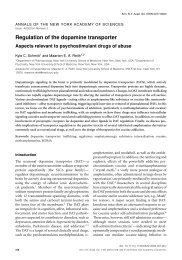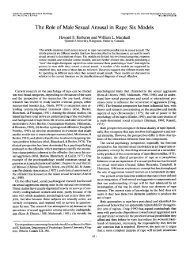How does stress increase risk of drug abuse - Addiction Research ...
How does stress increase risk of drug abuse - Addiction Research ...
How does stress increase risk of drug abuse - Addiction Research ...
Create successful ePaper yourself
Turn your PDF publications into a flip-book with our unique Google optimized e-Paper software.
Marlatt GA, Gordon JR (1985) Relapse prevention: maintenance<br />
strategies in the treatment <strong>of</strong> addictive behaviors. Guilford<br />
Press, New York<br />
Marlatt GA, Kosturn CF, Lang AR (1975) Provocation to anger<br />
and opportunity for retaliation as determinants <strong>of</strong> alcohol consumption<br />
in social drinkers. J Abnorm Psychol 84:652–659<br />
McCullough LD, Salamone JD (1992) Anxiogenic <strong>drug</strong>s beta<br />
CCE and FG 7142 <strong>increase</strong> extracellular dopamine levels in<br />
nucleus accumbens. Psychopharmacology 109:379–382<br />
McDougle CJ, Black J, Malison RT, Zimmermann RC, Kosten<br />
TR, Heninger GR, Price LH (1994) Noradrenergic dysregulation<br />
during discontinuation <strong>of</strong> cocaine use in addicts. Arch<br />
Gen Psychiatry 51:713–719<br />
McEwen BS, Stellar E (1993) Stress and the individual: mechanisms<br />
leading to disease. Arch Int Med 153:2093–2101<br />
McKay J, Rutherford M, Alterman A, Cacciola J, Kaplan M<br />
(1995) An examination <strong>of</strong> the cocaine relapse process. Drug<br />
Alcohol Depend 38:35–43<br />
McLellan A, Luborsky L, Woody G, O’Brien C, Druley K (1983)<br />
Predicting response to <strong>drug</strong> and alcohol treatments: role <strong>of</strong><br />
psychiatric severity. Arch Gen Psychiatry 40:620–625<br />
McNeil DW, Vrana SR, Melamed BG, Cuthbert BN, Lang PJ<br />
(1993) Emotional imagery in simple and social phobia: fear<br />
versus anxiety. J Abnorm Psychol 102:212–225<br />
Meaney MJ, Bhatnagar S, Larocque S, McCormick S, Shanks N,<br />
Sharma S, Smythe J, Viau V, Plotsky PM (1993) Individual<br />
differences in hypothalamic-pituitary-adrenal <strong>stress</strong> response<br />
and hypothalamic CRF system. Ann NY Acad Sci 697:70–85<br />
Meil WM, See RE (1997) Lesions <strong>of</strong> the basolateral amygdala<br />
abolish the ability <strong>of</strong> <strong>drug</strong> associated cues to reinstate responding<br />
during withdrawal from self-administered cocaine. Behav<br />
Brain Res 87:139–148<br />
Mello NK, Mendelson JH (1997) Cocaine’s effects on neuroendocrine<br />
systems: clinical and preclinical studies. Pharmacol Biochem<br />
Behav 57:571–599<br />
Mendelson JH, Mello NK, Teoh SK, Sholar M (1998) Cocaine tolerance:<br />
behavioral, cardiovascular and neuroendocrine function<br />
in men. Neuropsychopharmacology 18:263–271<br />
Miczek KA, Mutschler NH (1996) Activation effects <strong>of</strong> social<br />
<strong>stress</strong> on IV cocaine self-administration in rats. Psychopharmacology<br />
128:256–264<br />
Miller GA, Levin DN, Kozak MJ, Cook EW, McLean A, Lang PJ<br />
(1987) Individual differences in imagery and the psychophysiology<br />
<strong>of</strong> emotion. Cognit Emot 1:367–390<br />
Miller PM, Hersen M, Eisler RM, Hilsman G (1974) Effects <strong>of</strong><br />
social <strong>stress</strong> on operant drinking <strong>of</strong> alcoholics and social<br />
drinkers. Behav Res Ther 12:67–72<br />
Miller WR, Westerberg VS, Harris RJ, Tonigan JS (1996) What<br />
predicts relapse? Prospective testing <strong>of</strong> antecedent models.<br />
<strong>Addiction</strong> 91:S155–S171<br />
Monti PM, Abrams DB, Kadden RM, Cooney NL (1989) Treating<br />
alcohol dependence: a coping skills training guide. Guilford<br />
Press, New York<br />
Moss HB, Vanyukov MM, Martin CS (1995) Salivary cortisol responses<br />
and the <strong>risk</strong> for substance <strong>abuse</strong> in pre-pubertal boys.<br />
Biol Psychiatry 38:547–555<br />
Moss HB, Vanyukov MM, Yao JK, Kirillova GP (1999) Salivary<br />
cortisol responses in pre-pubertal boys: the effects <strong>of</strong> parental<br />
substance <strong>abuse</strong> and association with <strong>drug</strong> use behavior during<br />
adolescence. Biol Psychiatry 45:1293–1299<br />
Mulvaney F, Alterman A, Boardman C, Kampman K (1999)<br />
Cocaine abstinence symptomatology and treatment attrition.<br />
J Subst Abuse Treat 16:129–135<br />
Muraven M, Baumeister RF (2000) Self-regulation and depletion<br />
<strong>of</strong> limited resources: <strong>does</strong> self-control resemble a muscle?<br />
Psychol Bull 126:247–259<br />
Myers RD, Holman RB (1967) Failure to find <strong>stress</strong> <strong>of</strong> electric<br />
shock to <strong>increase</strong> ethanol intake in rats. Q J Alcohol 25:235–<br />
245<br />
Neiswander JL, Baker DA, Fuchs RA, Tran-Nguyen LT, Palmer<br />
A, Marshall JF (2000) Fos protein expression and cocaine<br />
seeking behavior in rats after exposure to a cocaine selfadministration<br />
environment. J Neurosci 20:798–805<br />
357<br />
Nestler EJ, Hope BT, Widnell KL (1993) Drug addiction: a model<br />
for the molecular basis <strong>of</strong> neural plasticity. Neuron 11:995–<br />
1006<br />
Newcomb MD, Bentler PM (1988) Impact <strong>of</strong> adolescent <strong>drug</strong> use<br />
and social support on problems <strong>of</strong> young adults: a longitudinal<br />
study. J Abnorm Psychol 97:64–75<br />
Parkinson JA, Olmstead MC, Burns LH, Robbins TW, Everitt BJ<br />
(1999) Dissociation in effects <strong>of</strong> lesions <strong>of</strong> the nucleus<br />
accumbens core and shell on appetitive pavlovian approach<br />
behavior and the potentiation <strong>of</strong> conditioned reinforcement<br />
and locomotor activity by D-amphetamine. J Neurosci 19:<br />
2401–2411<br />
Parkinson JA, Willoughby PJ, Robbins TW, Everitt BJ (2000) Disconnection<br />
<strong>of</strong> the anterior cingulate cortex and nucleus<br />
accumbens core impairs pavlovian approach behavior: further<br />
evidence for limbic cortical-ventral striatopallidal systems.<br />
Behav Neurosci 114:42–63<br />
Pelham WE, Lang AR, Atkeson B, Murphy DA, Gnagy EM,<br />
Greiner AR, Vodde-Hamilton M, Greenslade KE (1997) Effects<br />
<strong>of</strong> deviant child behavior on parental di<strong>stress</strong> and alcohol<br />
consumption in laboratory interactions. J Abnorm Child Psychol<br />
25:413–424<br />
Perret E (1974) The left frontal lobe <strong>of</strong> man and the suppression <strong>of</strong><br />
habitual responses in verbal categorical behavior. Neuropsychologia<br />
12:323–330<br />
Petrusz P, Merchenthaler I (1992) The corticotrophin releasing<br />
factor system. In: Nemer<strong>of</strong>f CB (ed) Neuroendocrinology.<br />
CRC Press, Boca Raton, pp 129–183<br />
Piazza PV, Le Moal M (1996) Pathophysiological basis <strong>of</strong> vulnerability<br />
to <strong>drug</strong> <strong>abuse</strong>: role <strong>of</strong> an interaction between <strong>stress</strong>,<br />
glucocorticoids, and dopaminergic neurons. Ann Pharmacol<br />
Toxicol 36:359–378<br />
Piazza PV, LeMoal M (1998) The role <strong>of</strong> <strong>stress</strong> in <strong>drug</strong> selfadministration.<br />
Trends Pharmacol Sci 19:67–74<br />
Piazza PV, Deminiere J, Le Moal M, Simon H (1989) Factors that<br />
predict individual vulnerability to amphetamine self-administration.<br />
Science 245:1511–1513<br />
Piazza PV Deminiere JM, Le Moal M, Simon H (1990) Stress and<br />
pharmacologically induced behavioral sensitization <strong>increase</strong>s<br />
vulnerability to acquisition <strong>of</strong> amphetamine self-administration.<br />
Brain Res 514:22–26<br />
Pierce RC, Kalivas PW (1997) A circuitry model <strong>of</strong> the expression<br />
<strong>of</strong> behavioral sensitization to amphetamine-like stimulants.<br />
Brain Res Rev 25:192–216<br />
Plotsky PM, Meaney MJ (1993) Early postnatal experience alters<br />
hypothalamic corticotrophin-releasing factor (CRF) mRNA,<br />
median eminence CRF content, and <strong>stress</strong> induced release in<br />
adult rats. Mol Brain Res 18:195–200<br />
Plotsky PM, Owens MH, Nemer<strong>of</strong>f CB (1995) Neuropeptide alterations<br />
in affective disorders. In: Bloom FE, Kupfer DJ (eds)<br />
Psychopharmacology: the fourth generation <strong>of</strong> progress.<br />
Raven Press, New York, pp 971–981<br />
Pohorecky LA (1991) Stress and alcohol interaction: an update <strong>of</strong><br />
human research. Alcohol Clin Exp Res 15:438–459<br />
Pohorecky LA, Huang X, Larson SA, Benjamin D (1995) The effects<br />
<strong>of</strong> triad housing on alcohol preference in male Long<br />
Evans rats. National Institute <strong>of</strong> Alcohol Abuse and Alcoholism<br />
<strong>Research</strong> Monograph Series 29: Stress, gender and alcohol-seeking<br />
behavior. NIH Publication No.95-3893 Washington<br />
D.C. pp 331–344<br />
Pomerleau CJ, Pomerleau OF (1987) The effects <strong>of</strong> a physiological<br />
<strong>stress</strong>or on cigarette smoking and subsequent behavioral<br />
and physiological responses. Psychophysiology 24:278–285<br />
Porrino LJ, Lyons D (2000) Orbital and medial prefrontal cortex<br />
and psychostimulant <strong>abuse</strong>: studies in animal models. Cerebral<br />
Cortex 10:326–333<br />
Prasad B, Sorg B, Ulibarri C, Kalivas P (1995) Sensitization to<br />
<strong>stress</strong> and psychostimulants: involvement <strong>of</strong> dopamine transmission<br />
versus the HPA axis. Ann NY Acad Sci 771:617–<br />
625<br />
Prasad BM, Hochstatter T, Sorg BA (1999) Expression <strong>of</strong> cocaine<br />
sensitization: regulation by the medial prefrontal cortex.<br />
Neuroscience 88:765–774










